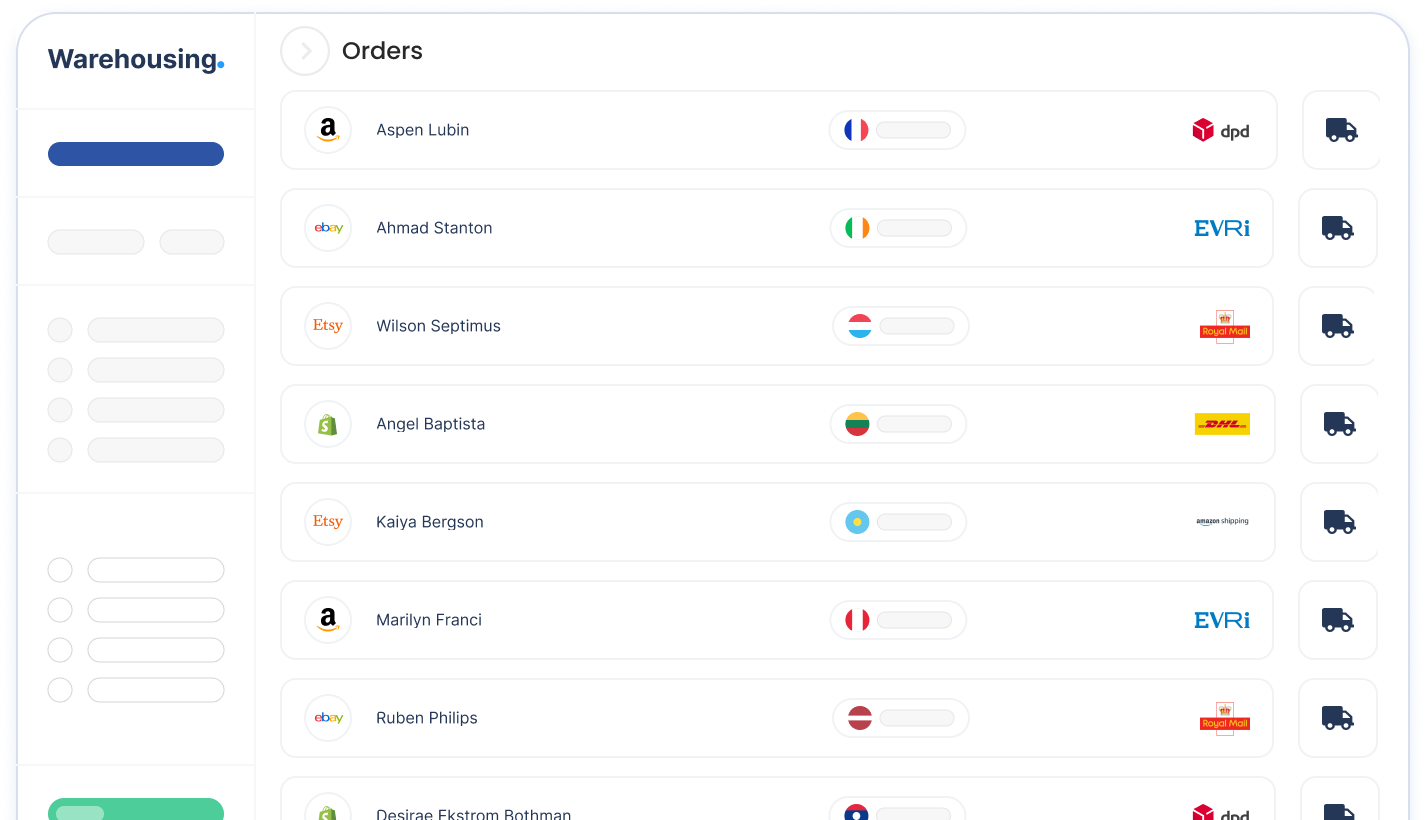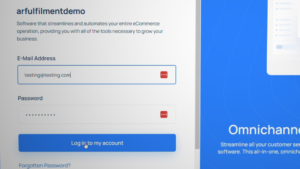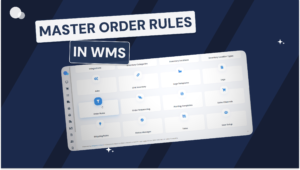Warehouse Management Software
The Top 17 Warehouse Management Systems (WMS)
In this guide, we’ll go over everything you need to know about warehouse management systems, along with a list of the top WMS providers out there.

Efficient warehouse management is a crucial element of any sucessful eCommerce and retail operation. A robust WMS system can optimise warehouse processes, speed up order fulfilment, and simplify inventory management, ensuring businesses meet customer demand while maximising operational efficiency. In this guide, we’ll go over everything you need to know about warehouse management systems, along with a list of the top WMS providers out there. Let’s get into it!
Who are the top Warehouse Management System suppliers in 2024?
Now, let’s look at some of the top warehouse management system vendors that businesses should consider in 2024. These vendors provide cutting-edge solutions, competitive features, and customisation options, catering to the diverse needs of retailers, warehouses and distribution centres:
Despatch Cloud: Features and Benefits
Armed with cutting-edge technologies, Despatch Cloud Warehousing is an advanced warehouse management system (WMS) designed specifically for eCommerce businesses looking to streamline and scale their post-purchase and integrate with more platforms and systems.
Key features include instant connection and real-time syncing with 80+ eCommerce platforms and 160+ couriers around the globe from one central hub, a scanning app accessible from any Android device, a dedicated returns portal, and a built-in email template builder for timely, on-brand customer communications.

Mintsoft: Features and Benefits
Mintsoft provides a unified platform for selling, fulfilling and despatching orders. Their software offers powerful order, inventory and warehouse management solutions for fulfilment businesses and online retailers, along with extensive integration capabilities, including 89+ couriers and 67+ online shopping platforms.
Check out their website to learn more.

Brightpearl: Features and Benefits
Brightpearl is a retail operating system that helps businesses automate operations and plan their inventory more efficiently.
Top features include inventory planning, multichannel order and stock management, a retail-focused CRM and a POS system, helping you sync your online and offline channels in real time. They also offer full training of your team, as a standard part of the onboarding process.
Check out their website to learn more.

Peoplevox: Features and Benefits
Check out their website to learn more.

Boxwise: Features and Benefits
Check out their website to learn more.

ShipHero: Features and Benefits
Check out their website to learn more.

SAP WMS: Features and Benefits
Check out their website to learn more.
BlueYonder: Features and Benefits
Check out their website to learn more.

Oracle Fusion Cloud Warehouse Management: Features and Benefits
Check out their website to learn more.

Centric WMS: Features and Benefits
Check out their website to learn more.

Boltrics: Features and Benefits
Check out their website to learn more.
WMS Manhattan: Features and Benefits
Manhattan is best known for its supply chain and omnichannel eCommerce solutions, which combine information from across the entire organisation. Their WMS is customised and used by major players like Argos, Crocs, and Scotch and Soda.
Check out their website to learn more.
Oracle: Features and Benefits
Check out their website to learn more.

Shipbob: Features and Benefits
Check out their website to learn more.
Orderwise: Features and Benefits
Check out their website to learn more.

Clarus WMS: Features and Benefits
Clarus WMS is a leading warehouse management software designed to bring Tier 1 features to businesses of all sizes, making advanced warehouse automation more accessible and affordable. Developed in collaboration with top supply chain and logistics companies, Clarus WMS offers a powerful yet intuitive platform that streamlines operations, boosts productivity, and eliminates the need for extensive training.
Check out their website to learn more.

“Finding the Warehousing software that can cope with the complexities of our business, all the different marketplaces, couriers and bringing them all together in an efficient way has been invaluable for our business and Despatch Cloud has helped us achieve that.”

John Stone
ShadowFoam – Managing Director
What is a warehouse management system and how does it work?
A warehouse management system is a software application or platform designed to support and optimise warehouse operations. It provides comprehensive visibility, automation, and control over key aspects of warehouse management, such as inventory tracking, order processing, picking, packing, and shipping.
The role of a WMS in eCommerce and retail
In the dynamic and rapidly evolving eCommerce landscape, efficient warehouse management is essential for meeting customer expectations and securing a competitive edge. A warehouse management system plays a vital role in ensuring smooth order fulfilment, accurate inventory management, and timely shipment processes. By leveraging a WMS system, distributors and retailers can efficiently manage picking, packing, and shipment processes, providing customers with a seamless post-purchase experience.
Warehouse management systems also offer advanced functionality to aid in stock management, replenishment, and returns, enabling businesses to adapt to market conditions and customer demand. With real-time visibility into inventory levels, businesses can make data-driven decisions, ensuring optimal stock levels, reducing carrying costs, and minimising stockouts.
The evolution of WMS over the years
Warehouse management systems have come a long way since their first introduction to the market, evolving to meet the ever-changing needs of modern supply chain operations.
In the past, warehouse management was primarily manual, with basic systems focusing on storage management and order tracking. However, with the advent of technology, WMS systems now integrate IT systems, logistics processes, and warehouse operations, revolutionising the way warehouses are managed.
Over the years, WMS systems have developed sophisticated features and functionalities to optimise warehouse operations. The historical development of warehouse management systems brought about advancements such as machine learning, automation, and voice-picking technology, improving operational efficiency, and reducing labour costs.
Today, warehouse management systems have gone beyond basic inventory control and order management, integrating with enterprise resource planning (ERP) systems to provide a holistic approach to warehouse operations. The latest WMS solutions also leverage cloud-based platforms, enabling businesses to access real-time data and enhance operational efficiency. These cloud-based systems offer flexibility, scalability, and accessibility, making them an emerging trend in warehouse management.
With the evolution of warehouse management systems, functionality has expanded to include dock management, yard management, labour management, transportation management, and more, catering to the diverse needs of warehouses and distribution centres of all sizes. The primary focus of WMS systems in recent years has been on meeting the demands of larger enterprises, ensuring the right products reach the right customers at the right time and right place.
What are the different types of Warehouse Management Systems in 2024?
Now, let’s explore the different types of warehouse management systems that are prevalent in 2024. Warehouse management systems can be broadly categorised into 3 types: standalone WMS, integrated WMS, and cloud-based WMS. Each type has its own set of advantages and considerations, catering to the specific needs and constraints of different businesses.
Standalone WMS: Pros and Cons
Standalone WMS systems are independent software applications specifically designed for warehouse management. They offer basic functionality and are generally more cost-effective, making them an ideal choice for smaller warehouses. However, standalone WMS systems may lack the extensive functionality and scalability of integrated systems, limiting their suitability for larger enterprises.
Pros of Standalone WMS:
- Cost-effective solution, suitable for smaller warehouses
- Independent system, not reliant on other software
- Relatively easy to implement and use
Cons of Standalone WMS:
- Limited functionality compared to integrated systems
- Scalability may be a challenge as the business grows
- Customisation options may be limited
Integrated WMS: Pros and Cons
Integrated WMS solutions, on the other hand, offer a seamless integration with other software systems, such as enterprise resource planning (ERP) systems. This integration enables efficient data exchange, real-time visibility, and automation, optimising warehouse processes and enhancing operational efficiency. While integrated WMS systems provide extensive functionality, they may require higher investment and customisation. However, for larger enterprises with complex warehouse operations, integrated WMS systems provide a comprehensive solution.
Pros of Integrated WMS:
- Seamless integration with other software systems, such as ERP
- Extensive functionality, including order management, inventory control, and demand planning
- Scalable solution catering to the needs of growing businesses
Cons of Integrated WMS:
- Higher investment and customisation requirements
- Implementation may be more complex compared to standalone systems
- Reliance on other software systems for full functionality
Cloud-based WMS: An Emerging Trend
Cloud-based warehouse management systems have emerged as a popular trend in 2024. These systems offer the flexibility, scalability, and accessibility required by modern businesses. By leveraging cloud technology, businesses can access real-time data, collaborate across locations, and optimise warehouse processes without the need for extensive IT infrastructure. Cloud-based WMS solutions provide convenience, cost-effectiveness, and operational efficiency, making them highly desirable for businesses looking to streamline their warehouse operations.
Advantages of cloud-based WMS:
- Flexibility and scalability to adapt to evolving business needs
- Accessibility from anywhere, allowing for collaboration across locations
- Reduced upfront costs and maintenance, as infrastructure is managed by the cloud provider
- Automatic updates and system enhancements, ensuring businesses always have access to the latest features
Key Features of cloud-based WMS:
- Real-time inventory tracking and visibility
- Seamless integration with other cloud-based solutions, such as transportation management systems
- Customisable modules and workflows to fit the specific needs of each business
- Enhanced operational efficiency, as multiple locations can be managed from a single platform
What are the benefits of using a WMS for eCommerce and retail?
A well-designed and effective WMS solution can unlock numerous advantages, improving order fulfilment, inventory management, and overall customer satisfaction.
Data-Driven Decision Making
A WMS system provides businesses with valuable insights into warehouse operations, inventory management, and order fulfilment processes. By leveraging this data, businesses can make informed decisions to reduce labour costs, improve inventory control, and optimise order-picking processes.
Faster Order Fulfilment
With a WMS system in place, businesses can expedite their order fulfilment processes, ensuring efficient picking, packing, and shipment processes. By automating repetitive tasks and streamlining warehouse operations, WMS systems enhance order fulfilment speed and accuracy, leading to improved customer satisfaction. With faster order processing, businesses can meet customer demand and maintain a competitive edge in the eCommerce and retail market.
Cloud-based WMS: An Emerging Trend
Implementing a warehouse management system can result in significant cost savings and error reduction. WMS systems optimise inventory management, reducing carrying costs and minimising errors caused by manual processes. The automation and visibility provided by WMS solutions ensure accuracy, reducing the risk of errors in order fulfilment, inventory management, and shipping processes. It also helps improve productivity in your warehouse, reducing labour costs.
When is it time to start using a WMS?
Deciding when to implement a Warehouse Management System (WMS) can be crucial for the growth and efficiency of your business. Whether you’re running a small warehouse or managing a large distribution center, the signs that it’s time to upgrade to a WMS often become clear through a few key indicators:
1. Rapid Growth
If your business is expanding quickly, and manual processes are becoming overwhelming, a WMS can streamline operations and help you scale efficiently. When orders start piling up, and you struggle to keep up with fulfillment, a WMS will automate processes and reduce errors.
2. Inventory Errors and Losses
Frequent mistakes in inventory counts or misplaced products are red flags. A WMS provides real-time visibility into your stock, eliminating manual tracking and reducing costly errors.
3. Difficulty Managing Orders Across Channels
With the rise of eCommerce, businesses are dealing with orders from multiple sales channels. A WMS integrates seamlessly with your platforms, ensuring inventory is updated across all channels in real-time, preventing overselling or stockouts.
4. Lack of Visibility and Reporting
If you’re struggling to get a clear picture of what’s happening in your warehouse, from stock levels to staff productivity, a WMS can provide detailed reports and analytics. This visibility is critical for decision-making and forecasting.
5. Customer Complaints and Delayed Shipments
Slow fulfilment, incorrect shipments, and rising customer complaints are telltale signs. A WMS improves order accuracy and speeds up the fulfillment process, leading to better customer satisfaction.
If your business is experiencing any of these challenges, it’s a strong indication that it’s time to invest in a WMS. The right system can not only save time and reduce costs but also give you the control and insight needed to optimize your entire warehouse operation.
Key considerations when choosing your WMS software
There are several key elements to keep in mind when choosing the right warehousing solution for your business.
Our experience with our own test-bed warehouse facility as well as working with eCommerce businesses of all industries and sizes has allowed us to identify the following general considerations:
- Scalability: Ensure the WMS can grow with your business, accommodating increased inventory and order volumes.
- Integration Capabilities: Opt for a system that seamlessly integrates with your existing tools, ERP, and eCommerce platforms.
- User-Friendly Interface: Prioritise a WMS with an intuitive interface to enhance user adoption and reduce training time.
- Real-time Analytics: Access to real-time data is essential for informed decision-making. Look for WMS solutions offering robust analytics.
- Customisation: Choose a WMS that can be tailored to your specific warehouse needs, ensuring a perfect fit for your operations.
- Implementation Support: Check for comprehensive support during the implementation phase to facilitate a smooth transition.
- Futureproofing: Select a WMS that adapts to industry changes and technological advancements, ensuring long-term relevance.
Alternative options to a WMS
If you’re not ready to fully implement a Warehouse Management System (WMS) but still need to manage your warehouse operations effectively, there are several alternatives you can explore. These options may offer a temporary solution, but they typically don’t provide the long-term scalability and efficiency that a full WMS delivers.
Manual Processes & Spreadsheets
Many smaller warehouses start by managing their operations manually or with basic tools like Excel spreadsheets. This option is inexpensive and easy to implement, but it can quickly become inefficient as your business grows. Manual tracking of inventory, orders, and shipments is prone to human error and doesn’t scale well with increasing complexity.Inventory Management Software
While not as comprehensive as a WMS, standalone inventory management software can help you keep track of stock levels, product locations, and order fulfilment. These systems are usually easier to set up and less expensive, making them a good starting point for smaller businesses. However, they often lack the more advanced features of a WMS, such as real-time tracking and automation of warehouse tasks.Enterprise Resource Planning (ERP) Systems
Some businesses manage their warehouse operations through an ERP system, which offers broader functionality across multiple business areas like finance, procurement, and supply chain management. While ERP systems can handle basic warehouse functions, they lack the specialisation and depth of a dedicated WMS. For larger operations or those with complex needs, a WMS is a more robust solution for warehouse-specific tasks.Order Management Software
Order management systems (OMS) focus on tracking sales orders and ensuring they are fulfilled. This software is beneficial for businesses dealing with eCommerce or high-volume sales but doesn’t provide the comprehensive warehouse functionality that a WMS offers. It can, however, serve as a bridge between manual processes and a full-fledged WMS by improving order accuracy and inventory visibility.Outsourcing Warehousing to 3PL Providers
Another alternative to implementing a WMS is outsourcing your warehousing and fulfilment operations to a third-party logistics (3PL) provider. These companies often use advanced WMS software themselves, so you benefit from the technology without needing to implement it. However, outsourcing means giving up control over certain aspects of your operations, which may not suit every business.
While these alternatives can serve as temporary solutions, they often fall short in terms of scalability, automation, and overall efficiency. As your business grows and operational demands increase, a dedicated WMS like Despatch Cloud will provide the robust functionality needed to streamline and optimise your warehouse for long-term success.
How long does it take to implement a WMS?
The timeline for implementing a Warehouse Management System (WMS) can vary depending on several factors, but typically it ranges from a few weeks to several months. Here’s what influences the duration:
Warehouse Size and Complexity
The larger and more complex your warehouse operation, the longer the implementation may take. Multiple locations, high SKU counts, or intricate workflows often require more time for system configuration and testing.Customisation Needs
If your business has specific requirements, such as integrating with other software platforms or custom workflows, these customisations can extend the implementation timeline. However, modern WMS solutions often come with built-in flexibility, reducing the need for extensive development.Data Migration
Transferring data, such as inventory levels and product information, from legacy systems to your new WMS can be a time-consuming process. The accuracy and cleanliness of your existing data can also affect how smoothly this process goes.Training and Change Management
The time it takes to train your staff on using the new WMS can vary. If the system is intuitive and user-friendly, like Despatch Cloud’s, training can be quick and seamless. However, getting your team fully onboard and comfortable with the new processes can take longer in some cases, especially if there’s significant resistance to change.Testing and Fine-Tuning
Before going live, your WMS needs to be thoroughly tested to ensure it works as intended within your operations. This includes testing for accuracy, performance, and integration with other systems. Any necessary adjustments or fine-tuning could add to the timeline.
On average, small to mid-sized warehouses can implement a WMS in 6 to 12 weeks, while larger, more complex operations may take up to 6 months. With a platform like Despatch Cloud Warehousing, designed for quick deployment and ease of use, you can streamline the process and start seeing benefits sooner.
WMS software costs
When considering the implementation of a Warehouse Management System (WMS), cost is a key factor that businesses must take into account. WMS software costs can vary widely depending on factors such as the size of your operation, the complexity of your workflows, and the features you require. Here’s a breakdown of the different types of costs associated with WMS software:
Upfront Licensing or Subscription Fees
WMS providers typically offer either a one-time licensing fee or a subscription-based model. Subscription models, which are usually cloud-based, often include access to the software, regular updates, and support services. Prices can range from a few hundred pounds per month for smaller systems to several thousand pounds for more advanced, feature-rich solutions.Implementation Costs
The process of implementing a WMS involves system integration, data migration, and staff training. These costs can vary depending on how complex the implementation is and how much customisation is required for your specific warehouse operations. For smaller warehouses, implementation costs may be lower, but for larger or more complex operations, this can become a significant investment, potentially reaching tens of thousands of pounds.Hardware Requirements
In addition to software costs, businesses will need to invest in hardware such as barcode scanners, mobile devices, printers, and potentially RFID systems. These tools are essential for maximising the efficiency of a WMS, enabling real-time tracking and automation of warehouse processes. Depending on the size of your warehouse and the amount of equipment needed, hardware investments can be a major cost consideration.Maintenance and Support
Ongoing costs for maintenance and support services are also an important consideration. Subscription models often bundle these into the monthly fee, but if you’re using a licensed system, you may have to pay separately for support, upgrades, and troubleshooting, which can add to the long-term cost of running your WMS.
Ultimately, WMS software is a significant investment that should be evaluated based on its potential to optimise warehouse operations and improve efficiency in the long run. While the costs can be substantial, the return on investment often justifies the expense, especially for businesses looking to scale.
Conclusion
Choosing the right Warehouse Management System (WMS) is crucial for the success of any eCommerce or retail business. With the evolution of technology, WMSs have become more efficient and capable of meeting the demands of the industry, leveraging AI, automation and IoT to introduce new, powerful features and help businesses stay ahead in the competitive eCommerce landscape. Whether you opt for a standalone, integrated, or cloud-based system, the benefits of using a WMS are undeniable. It allows for data-driven decision-making, faster order fulfilment, and cost reduction. By implementing best practices such as efficient processes, barcode scanning, and data-driven inventory planning, businesses can optimise warehouse operations. Finally, keep an eye out for the top WMS vendors in 2024 to ensure access to the latest features and technological developments.
Not convinced yet?
Check out this 3-minute demo of our Warehouse Management System. Discover essential features as Adam guides you through our user-friendly interface. Want a personalised tour of our product? You can book your free demo with one of our product specialists by clicking the button below:




